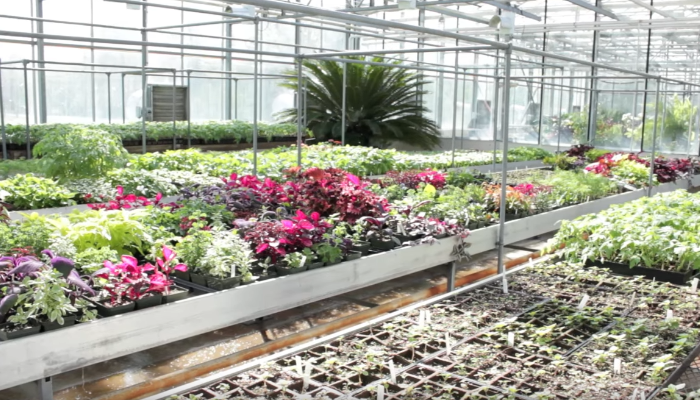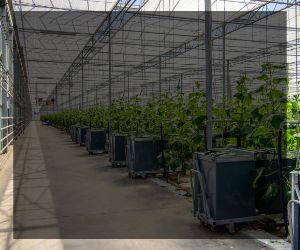
Commercial Horticulture

The University of Delaware Cooperative Extension Commercial Horticulture Program provides non-biased, research based information for growers, retailers, greenhouse operators, landscape contractors, landscape maintenance professionals and other green industry professionals in Delaware, the region, and the nation. Horticulture is the science, art, technology and business involved in intensive plant cultivation for human use. It includes non-food crops such as flowers, trees, shrubs, lawns, etc. and food crops (fruits, vegetables, mushrooms and culinary herbs), which are covered in the UD Vegetable and Small Fruits Program.
The needs of the green industry are addressed with applied research and demonstration projects focusing on sustainable landscape installation and management as well as pest control. The information and knowledge is disseminated through a range of venues in collaboration with the Delaware Nursery and Landscape Association (DNLA), including educational meetings, short courses, tours, publications, newsletters, direct contact and this website.
A certified nursery professional program is administered through the DNLA to help industry professionals learn technical information and demonstrate their professional standing.
DNLA (Delaware Nursery and Landscape Association)
Summer Turf and Nursery Expo
August 14 @ 8:00 am - 5:00 pm
The Summer Turf & Nursery Expo will be held Wednesday, August 14 at UD Botanic Gardens in Newark
Come spend the day at the DNLA’s Summer Turf & Nursery Expo. Increase your knowledge, improve your skills, visit with exhibitors, and earn valuable pesticide and nutrient management credits. A Hearty Picnic Luncheon Will Be Provided.
Topics include:
- Tantalizing Turfgrass
- Groundcover Trials – And the Winners Are…
- UDBG Trial Garden – Color Galore
- Pest/Disease Walk
- Turfgrass & CNP Plant ID Challenge
- Why Didn’t I think of That?
- Imagine This – Design of the Future
This day will award 4 Pesticide Applicator Recertification Credits for DE Category 03, 10, PA. Credits from PA, MD and ISA will also be available. 1.5 DE Nutrient Management CEUs will also be available.
Registration includes lunch, tradeshow and seminars.
All fees are non-refundable. Registration substitutions may be made on day of meeting at no charge.
The event will be held rain or shine at:
UD Botanic Gardens
531 South College Avenue (Rt. 896)
Newark, DE 19716
Option 1:
Download the Registration Brochure and return with payment
Option 2:
Carrie Murphy, New Castle County (302) 831-1426 or cjmurphy@udel.edu
Plant of the Year
- Plant of the Year Blog - Each year the Delaware Nursery and Landscape Association selects a woody and herbaceous plant that thrives in Delaware and should receive more attention in the trade. Plants are suggested by a team of loca professionals and the DNLA board votes on the winners. A one-page colorful flyer is developed to promote the winners each year.
Native Plant Nurseries serving Delaware and the region
- The DNLA, Delaware Department of Agriculture, and the University of Delaware Cooperative Extension have worked together to develop a list of nurseries who provide native plant material to Delawareans.
- Click Native Plants – Wholesale Only Nurseries for a list of Nurseries serving Wholesale customers only.
- Click Native Plants – Retail / Wholesale for a list of Nurseries serving retail/wholesale customers.
Publications
- Nursery and Garden Center Management Manual – This is a manual for use in teaching nursery and garden center management to college students. For each of 17 chapters, the manual includes a fill-in-the-blank outline of class notes, and a collection of reprinted articles from trade journals.
- Establishing and Operating a Garden Center: Requirements and Costs NRAES-161
The Greenhouse and Nursery industry thrives on the Eastern Shore. Delaware has several large greenhouse operations and nurseries. There are also major nurseries in our neighboring state of Maryland. The Green Industry Consortium is a national group of horticulturists and Ag Economists who have been addressing the needs of the Green Industry for over 25 years. The Green Industry Consortium has developed many publications for this industry. The Greenhouse publication is for start-up or existing greenhouses and was part authored in Delaware. The Specialty crops initiative has provided funding for a number of specialty crops projects in the United States. A project conducted in Delaware to help nurseries explore growing more native species is listed below.
The Livable Lawns Program certifies lawn care companies that follow environmentally-friendly practices in fertilizer application while educating property owners.
- A brochure is available to print and leave with customers to explain proper lawn management
- Videos on the Delaware Livable Lawns website provide resources to show homeowners how to take and interpret a soil sample; and how to properly apply fertilizer to their lawns.
- A brochure entitled Livable Lawns: Managing a Healthy Lawn is now available.
Water Quality Research
- Winterthur/Applecross -This multidisciplinary project research site is located at Winterthur Museum and Gardens, where the team will compare the quality of a stream impacted by traditional mowed landscapes versus another stream that only receives runoff from meadows, forests and landscape beds. One of the primary goals of the project is to curb water pollution at its source — preventing pollution in the first place rather than waiting to treat contaminated water after it enters waterways.
Green Industry Training at your Site
Delaware Cooperative Extension will work with you to conduct a workshop at your site, for your employees. A menu of available topics is included below.
For a one-hour talk from the prepared menu, the cost will be $300 for a minimum of 10 people. If you have more than 10 people, it will be an additional $5/person. For talks that exceed one hour and/or include nutrient management or pesticide credits, there will be an additional cost determined by the County Agent.
Scheduling is based on the availability of the instructor with expertise in the topic you choose. You will need to provide a meeting space to accommodate attendees. Please schedule early to have the best chance of getting the extension professional with the appropriate expertise on your chosen topic in a timely manner.
Available topics:
turf management/maintenance
integrated pest management
insect identification and management
weed identification and management
disease identification and management
plant diagnostics with microscopy
abiotic and cultural plant problems
soil basics - chemical and physical properties
sustainable landscapes
backyard wildlife habitat
basic vegetable production
soil testing for turfgrass systems
pesticide safety and handling
fertilizer management
general mathematics for pesticides/fertilizers
spreader/sprayer calibration
understanding pesticide labels
post-construction stormwater management
water quality in stormwater ponds
invasive plant management
Our team is willing to work with you to offer any other nursery or landscape industry topic for which we have expertise, and that interests you and your employees. Please discuss with your County Agent.
Please contact your County Agent for additional details and to schedule:
Carrie Murphy, Horticulture Agent, New Castle County: (302) 831-2506 or cjmurphy@udel.edu
Blake Moore, Renewable Resources Agent, Kent County: (302) 730-4000 or rbmoore@udel.edu
Tracy Wootten, Horticulture Agent, Sussex County: (302) 856-7303 or wootten@udel.edu
Related Fact Sheets
Filter by Agriculture
Filter by Horticulture
All Results
-
SOYBEAN VEIN NECROSIS VIRUS
Soybean Vein Necrosis Virus is an Orthotospovirus. This virus can be seed borne or vectored by multiple thrips species.
-
TAR SPOT OF CORN
Tar spot is caused by the fungal pathogen Phyllachoramaydis. Under favorable conditions for disease, yield loss on susceptible hybrids can be severe.
-
ALFALFA WEEVIL CONTROL IN ALFALFA
The alfalfa weevil (AW) overwinters in both the adult and egg stages. Although egg laying occurs in the fall and spring, larvae hatching from spring-laid eggs cause the most damage. Eggs are laid in the alfalfa stem any time temperatures are above 48 degrees F.
- 1
- 2
- 3
- 4
- 5
- 6
- 7
- >>


















































































































